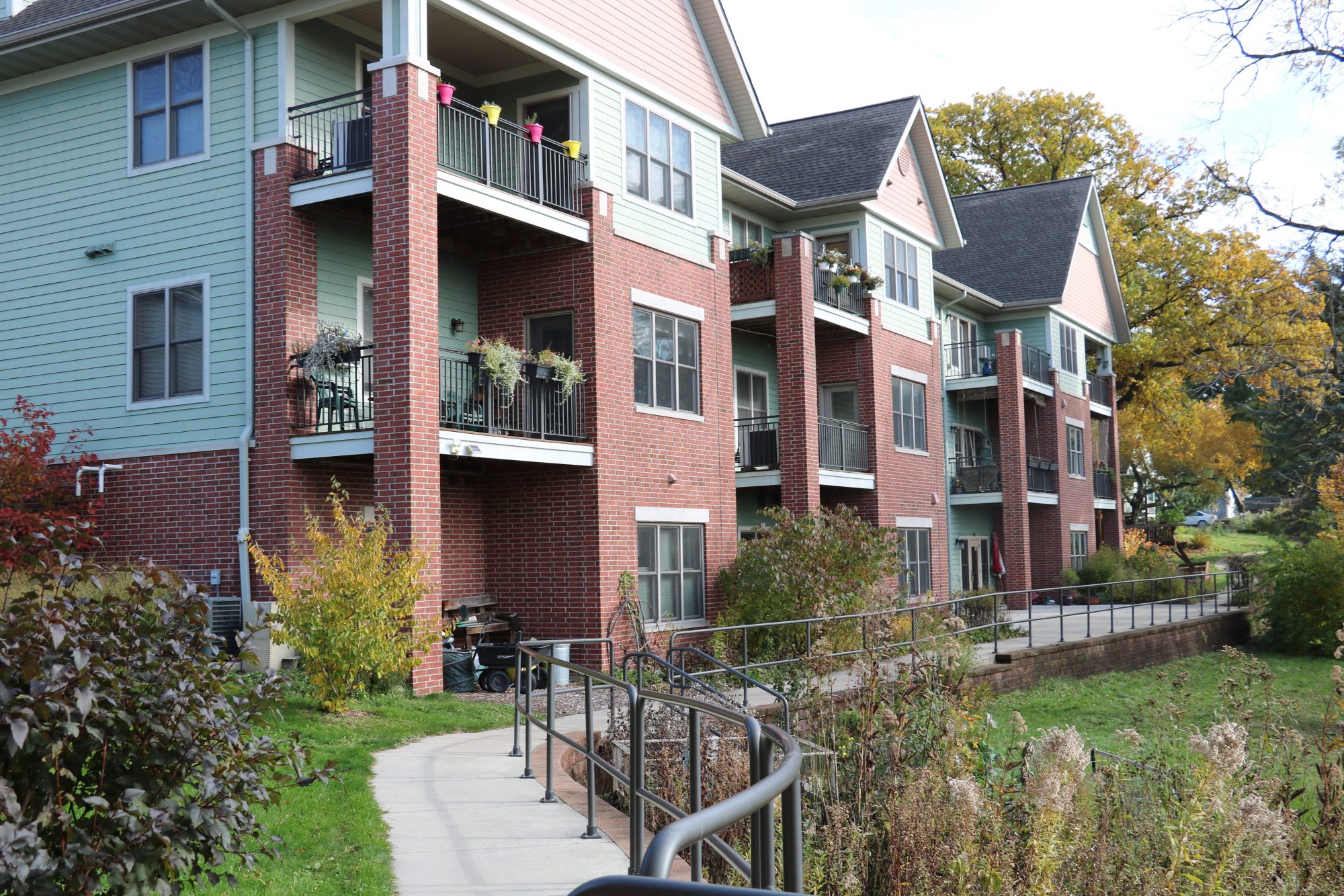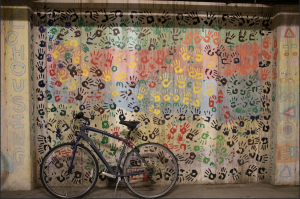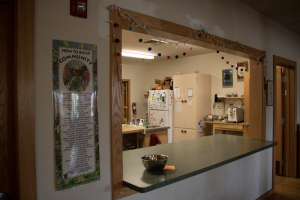Cohouse, co-exist

cohouse, coexist
Photo by Sam Jones
Finding a home in cooperative housing

Illustration by Lily Oberstein
Plates and assorted silverware clank among muffled conversations as the members of Village Cohousing Community wrap up their monthly meeting. This evening, they debated the removal of a shelf housing mugs and other dishware in their communal kitchen — and while they didn’t decide where to relocate the shelf, the group reached a consensus that it would, in fact, be removed. The argument wasn’t necessarily heated, but there was plenty of discussion and opinion-sharing within the bounds of their cozy, yet open dining room, lined with faded photos of past members and artwork from around the world.
This kind of open decision-making is central to the concept of cohousing — where a group of individuals, couples and families live in a single development with independent, private units and extensive common spaces. They proliferated in Scandinavia in the 1960s and are now popping up in the U.S. According to the Foundation for Intentional Community, an association representing cohousing organizations, there are currently around 500 cohousing groups across the nation, 23 of which are in Wisconsin — mostly spread between Madison and Milwaukee.
Cohousing and intentional communities may seem straight out of a cult documentary or reminiscent of the drug-fueled communes of the 1970s, but today’s cohousing arrangements are vastly different. In reality, residents say these institutions offer great emotional and physical support and foster members’ shared values of peace-making and relationship-building.
Application processes for these communities vary, but in-person meetings to ensure residents are a good fit — in terms of personality, attitudes, principles — are compulsory. Standard rent typically rivals that of the general Madison housing market, but many communities maintain a certain percentage of affordable units in hopes of nurturing common goals of inclusivity.
Once an application has been accepted and folks move in, they may (voluntarily, of course) join committees to cook meals, maintain landscaping or plan events to fully take advantage of the interdependent and reciprocal nature of their micro-society.
Yet not all cohousing communities look the same as Village. Some take the form of high-rise metropolitan condo buildings and others are an amalgamation of historic buildings in a town of 65 — but they are each bound together by the value of democratic decision-making.

Charles Anaman, a member of Village Cohousing, embodies the loyalty, compassion and trust of cohousing communities across the nation.
Charles Anaman, who recently moved into Village Cohousing with his wife and 4-year-old son, Oliver, grew up in a West African boarding school and was constantly moving, calling 16 countries home over the past 25 years. Yet, in each of these countries, Anaman clung to his principles of social trust and community ethic — along the way learning how to best mitigate conflict and instill a sense of democracy in all decisions.
“I had the environment growing up to know how to deal with these kinds of things, so I came in with my eyes fully open,” Anaman says. “These are people that miss that environment where you can have respect for yourself, have respect for other people, and be able to tell each other what you are doing is wrong or what you are doing is nice. But if you want it, you have to work toward it, you can’t just sit back.”
Yearning to belong to a tight-knit community is the primary reason that most people decide to live in these shared living situations and oftentimes results in unique diversity among members.
Arboretum Cohousing, located near St. Mary’s Hospital in Madison and known as Arbco, has a mix of people coming from different backgrounds and of ranging ages, experiences and abilities.
“We have a number of people who are either physically or cognitively disabled, and it’s been really great for them and their families, too, because there’s a support system in place and there’s people around to help if they need it,” says Arbco member Janet Kelly. Beyond these rigid, identity-based characteristics, Kelly also noted Arbco’s baseline priorities across its full membership: sustainability, togetherness and positive dialogue.
“Ironically, there’s a cohousing Listserv, a national one, and they’ve done surveys and they say that three-quarters of people who live in cohousing are introverts,” Kelly says. “I don’t know exactly what that means, but it’s sort of like those people are drawn to where you have informal social contact everyday, where you don’t have to go to a bar or a huge dinner party or something like that.”
Introverted or not, having 20 or so people just down the hallway or across a courtyard can be massively rewarding in difficult times — especially when raising a child.
Jen Rehm lives at Arbco with her 3-year-old and infant and has benefited greatly from the cohousing environment.
“I’m a single parent by choice, and I don’t think I could do that without Arboretum Cohousing, or without a cohousing system in general,” Rehm says.

Arbco offers community living and is located near downtown Madison. (Photo by Sam Jones)
Anaman also has found a sense of peace in raising Oliver alongside a group of 23 other adults.
“He grew up being handed off to complete strangers, and he’d be fine, he’d be safe. We kind of have to rein him in, because he just wants to go off with everyone and be friends,” Anaman says. “So, it’s not been difficult — if anything, it’s been more like trying to get him to understand people’s own boundaries.”
Oliver buzzes around the kitchen and adjacent TV room, stopping only for a quick high-five and to tell me that his favorite parts of his new house are the big yard and a futon fit for slumber parties.
Still, there are greater benefits to cohousing than simply having a condo full of last-minute babysitters. Studies by the University of Texas support claims that a healthy social life correlates with longer lifespans, improved mental health and a stronger immune system. They also found that suppressed socialization is correlated with increased mortality.
This past September and October, a cohousing development particularly interested in the universal benefits of living with others filled its walls with residents. Linden Cohousing, a three-story development sharing a parking lot with Madison Circus Space (a place for circus and movement arts groups), is attempting to fully assimilate into the east side community. While members won’t be flipping through the air or spinning between two hoops (German wheels, to be accurate), they do hope to emulate the same collaborative and egalitarian vibe of their carnival neighbors.
With rentable studio space — as the previous building at this location was a hub for local artists and creatives — in addition to designating a quarter of their units as permanent affordable housing, the minds behind Linden Cohousing have prioritized accessibility and equity.
“It’s set up such that our needs, as they change, will be taken into accommodation and we will be able to live in that community longer,” says Bert Zipperer, president of Linden Cohousing’s Board of Directors. “With the support of our neighbors and other friends, I think on an emotional level, on a psychological level, on a physical level, in all those ways I think there’d be more support long term.”
This is a common theme among cohousing facilities — each notes the accessibility features available in their buildings, from accomodations for people who use wheelchairs to a system of different colored circles to indicate to children which rooms are off-limits.
Yet these facilities are also forced to adapt in other ways due to the escalation of climate change and other environmental issues.
With an advanced recycling program, roof solar panels and a garage stocked full of bikes, Arbco has gone above and beyond the inherent sustainability features associated with cohousing. Intentional design of window placement, heating and cooling elements, and ridesharing capabilities typically accompany condos and other centralized rental properties, but the unique intersection with decision-making policies allows for residents to advocate for such features as renewable energy generators and compost systems.

A garage full of every shape and size of bike, collaboratively curated murals, and member vehicles sits below the Arbco housing development. (Photo by Sam Jones)
Membership in co-housing communities is not always stable or consistent. Dreamtime Village, a co-housing collective located in the rural town of West Lima, about an hour east of La Crosse, has experienced fluctuations in membership and involvement in recent years.
mIEKAL aND, an artist and long-time member of Dreamtime, says that with the death of his first wife in 2004, the community stopped doing as much public outreach and events.
“She was sort of the front person for our community, so when people would come to visit, she was like the hostess, and she was perfect for behind-the-scenes stuff,” mIEKAL aND says. “So that really changed the whole complexion of kind of how active we were, how many public events we did and that kind of stuff because she was really the force behind all that.”
Though members recognize that Dreamtime will need to recruit younger folks to curb the barriers of living in such a rural location — West Lima’s population hovers around 65 — their philosophy differs dramatically from that of other cohousing developments. It also maintains much more of the eccentric vibe many associate with communal living.
The idea of the “dream time” has resulted in shared-responsibility community that currently consists of an old post office and teachers’ hotel transformed into living quarters, as well as their impressive orchards and gardens.
By making each experience an art form — harvesting apricots and elderberries for winemaking, hunting for game or writing poetry — through meditative song and dance, or simply fostering hyperawareness of one’s surrounding, mIEKAL aND and his fellow dreamtimers have formulated a modern version of this philosophy.
Regardless of the clear distinctions between these four cohousing establishments, they all value something a bit less philosophical and dense than community ethic or democratic engagement: food!
Chicken coops line the perimeter of Arbco, Dreamtime harvests medicinal and edible herbs, and periodic community dinners — with shared cooking, cleaning and planning responsibilities — are a fixture among cohousing units across the nation.

Arbco’s communal kitchen and dining area is home to much of their community-building, occasionally with the help of a morale-boosting poster or two. (Photo by Sam Jones)
Arbco’s massive, dorm-style kitchen is adjacent to its dining room, where an equally massive gourd sits next to a scribbled list of children’s names. At a recent common meal, members dragged out a scale to determine which of their 27 children weighed more than the mammoth squash. While big-kid aspirations may have been flattened in the process, this is an archetypal example of the happenchance camaraderie-building among such communities.
Lou Host-Jablonski worked with Design Coalition on the development of both Village Cohousing and Arbco’s facilities and is optimistic about what is to come in the realm of shared living spaces.
“If you look at the society at large, it’s never going to be 100 percent of the population, but it’s just going to keep incrementally growing as people understand the benefits of it,” Host-Jablonski says. “The more people will have exposure to it, it will just become this normal thing like it’s become in Europe.”
As for the physical design of these future developments, Host-Jablonski believes the biggest barrier is not dissension with neighborhood associations or acquiring building permits, but rather is hitting that perfect “sweet spot” of dwelling units — “between 20 and 40, 45” — where there are enough residents to distribute work appropriately but still know each individual on a personal level.
Even if cohousing never becomes fully mainstream, Host-Jablonski and other cohousing supporters believe we can all learn a thing or two from these folks who have abandoned the traditional housing model in pursuit of greater connection to those around them — anarchists, seniors, artists, preachers, students, children and everyone in between.
“What brings us together is community and living in community,” says Village member Chucho Alvarado. “I think the way I can explain that very quickly is that the whole is more than the sum of the parts.”
